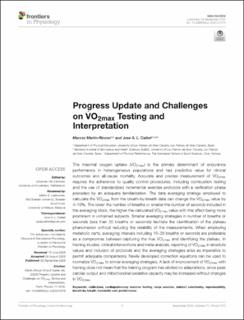| dc.contributor.author | Martin-Rincon, Marcos | |
| dc.contributor.author | Calbet, Jose Antonio Lopez | |
| dc.date.accessioned | 2021-06-04T15:21:58Z | |
| dc.date.available | 2021-06-04T15:21:58Z | |
| dc.date.created | 2020-09-24T18:52:42Z | |
| dc.date.issued | 2020 | |
| dc.identifier.citation | Frontiers in Physiology. 2020, 11, Artikkel 1070. | en_US |
| dc.identifier.issn | 1664-042X | |
| dc.identifier.uri | https://hdl.handle.net/11250/2757994 | |
| dc.description | This is an open-access article distributed under the terms of the Creative Commons Attribution License (CC BY). The use, distribution or reproduction in other forums is permitted, provided the original author(s) and the copyright owner(s) are credited and that the original publication in this journal is cited, in accordance with accepted academic practice. No use, distribution or reproduction is permitted which does not comply with these terms. | en_US |
| dc.description.abstract | The maximal oxygen uptake (VO2max) is the primary determinant of endurance performance in heterogeneous populations and has predictive value for clinical outcomes and all-cause mortality. Accurate and precise measurement of VO2max requires the adherence to quality control procedures, including combustion testing and the use of standardized incremental exercise protocols with a verification phase preceded by an adequate familiarization. The data averaging strategy employed to calculate the VO2max from the breath-by-breath data can change the VO2max value by 4-10%. The lower the number of breaths or smaller the number of seconds included in the averaging block, the higher the calculated VO2max value with this effect being more prominent in untrained subjects. Smaller averaging strategies in number of breaths or seconds (less than 30 breaths or seconds) facilitate the identification of the plateau phenomenon without reducing the reliability of the measurements. When employing metabolic carts, averaging intervals including 15 to 20 breaths or seconds are preferable as a compromise between capturing the true VO2max and identifying the plateau. In training studies, clinical interventions and meta-analysis, reporting of VO2max in absolute values and inclusion of protocols and the averaging strategies arise as imperative to permit adequate comparisons. Newly developed correction equations can be used to normalize VO2max to similar averaging strategies. A lack of improvement of VO2max with training does not mean that the training program has elicited no adaptations, since peak cardiac output and mitochondrial oxidative capacity may be increased without changes in VO2max. | en_US |
| dc.language.iso | eng | en_US |
| dc.subject | breath-by-breath | en_US |
| dc.subject | calibration | en_US |
| dc.subject | cardiopulmonary exercise testing | en_US |
| dc.subject | indirect calorimetry | en_US |
| dc.subject | metabolic cart | en_US |
| dc.subject | performance | en_US |
| dc.subject | ramp exercise | en_US |
| dc.subject | reproducibility | en_US |
| dc.title | Progress update and challenges on VO2max testing and interpretation | en_US |
| dc.type | Peer reviewed | en_US |
| dc.type | Journal article | en_US |
| dc.description.version | publishedVersion | en_US |
| dc.rights.holder | © 2020 Martin-Rincon and Calbet | en_US |
| dc.source.pagenumber | 8 | en_US |
| dc.source.volume | 11 | en_US |
| dc.source.journal | Frontiers in Physiology | en_US |
| dc.identifier.doi | 10.3389/fphys.2020.01070 | |
| dc.identifier.cristin | 1833220 | |
| dc.description.localcode | Institutt for fysisk prestasjonsevne / Department of Physical Performance | en_US |
| dc.source.articlenumber | 1070 | en_US |
| cristin.ispublished | true | |
| cristin.fulltext | original | |
| cristin.qualitycode | 1 | |
